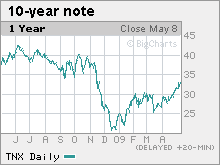Treasurys advance
Prices for US debt increase as ongoing economic concerns curb investors' appetite for risk.
NEW YORK (CNNMoney.com) -- Treasury prices rose Monday as the Dow hit a triple-digit selloff after a two-month rally and the Federal Reserve prepared to buy U.S. debt throughout the week.
Separately, a key interbank lending rate fell to a fresh all-time low.
Bonds have trended lower in recent weeks as stocks have advanced on signs the U.S. economy could recover sooner than expected. But many analysts worry that the optimism may be overdone given the depth of the recession.
The Dow Jones industrial average (INDU) lost 140 points, or 1.7%, with 30 minutes into the session. The S&P 500 (SPX) index lost 17 points, or 1.9%. Both the Dow and S&P 500 ended the previous session at four-month highs.
Treasurys, which are considered one of the most secure assets available, often rise when stocks fall as demand for safety outweighs investors' appetite for risk.
The Treasury announced it auctioned $31 billion in 13-week notes and $29 billion in 26-week bills Monday.
The U.S. central bank will purchase an undisclosed amount of Treasurys as part of its plan to lower interest rates on certain types of business and consumer loans. The Fed will also buy U.S. debt on Tuesday and Thursday.
Bond prices: The benchmark 10-year note was up 1-1/32 to 99 21/32 and its yield fell to 3.2% from 3.29%. Bond prices and yields move in opposite directions.
The 2-year note gained 5/32 to 99 30/32, and yielded 0.9%.
The 30-year bond was up 1-19/32 to 101 9/32, and its yield was 4.2%.
The yield on the 3-month was 0.16%.
Lending rates: A key bank-to-bank lending rate fell to its fifth straight all-time low Monday, suggesting the credit crisis is waning for many financial institutions.
The 3-month Libor fell to 0.92% from 0.94% Friday, according to Bloomberg.com. The overnight Libor rate held steady at 0.23%.
Libor, the London Interbank Offered Rate, is a daily average of rates that 16 different banks charge each other to lend money in London. It is a closely watched benchmark and is used to calculate adjustable-rate mortgages. More than $350 trillion in assets are tied to Libor.
Last week, the 3-month rate dropped below 1% for the first time since 1986, when the British Bankers Association started keeping records. ![]()


